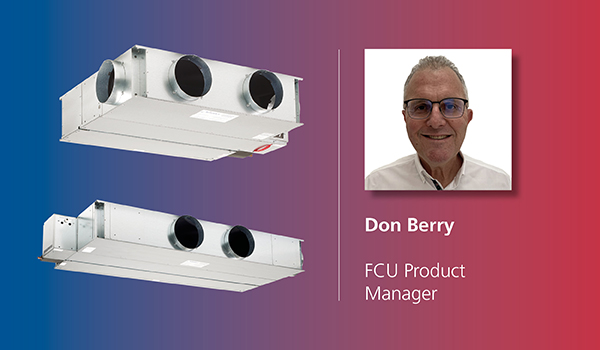Don Berry – FCU Product Manager for Smith’s Environmental Products
Over the past 12 months Smith’s has invested significantly in redeveloping their range of void-mounted and cased 4-pipe Aegean fan coil units to both improve the range and to concentrate on innovative modern design requirements as the HVAC industry moves to a more efficient and carbon-neutral future.
Fan Coil Units have been around for a long time and until recently were not necessarily the first choice for applications where zonal heating in larger buildings is required. However, with recent changes in forthcoming legislation concerning harmful refrigerant gases restricting the installation of air conditioning units in certain applications coupled with the requirements to drive down energy costs specifiers are once again looking to fan coil units as a more environmentally friendly solution.
What is a fan coil unit and why fit them?
A fan coil unit (FCU) is an air conditioning unit that draws room air into the ceiling/wall void, filters it and then heats or cools it before supplying it back to the room at the required temperature. Fresh air can be introduced from centrally conditioned air handling units into the void, this is then induced into the fan coil unit. In the UK, this is done at very low noise levels.
Fan coil units ideally function when heating and cooling requirements are designed into a zone or room by room and are typically specified where extremely low noise levels are required with very high efficiency and accurate temperature control.
Zoning control of the whole system is easy and can be divided into areas of individual rooms, usage, time and where a rooms aspect is subject to solar gain. A good example where fan coil units are a good fit is in hotel applications. The FCU can be activated either when the room guest entry card is issued at reception or when it is inserted into the room wall socket. The desired room temperature can quickly be achieved and when a window is opened the system can be set to respond by going to stand-by mode.
Fan motors in FCUs have changed in recent years from AC powered to EC (electronically commutated) DC brushless motors with the electronics integrated into the motor assembly so that the system is only supplied by mains AC. The change to EC fan motors has meant that savings of up to 80% are achievable, and they also make speed control via a 0/10v signal very simple.
In terms of ongoing maintenance FCU are low maintenance plant with only scheduled filter checks necessary and filter replacement when required.
Heating and cooling distribution around buildings
There is a significant saving in heat gain/loss efficiency and space within a building when the energy distribution is from heating and cooling water to service fan coil units rather than ducted air from central station air handling plant.
Central station chilled/hot water systems can be more a more expensive initial investment than smaller, individual air conditioning systems but they give much higher running efficiency and give a good return financially both on energy costs and maintenance in a relatively short timeframe. There are also many reasons why it is better to pipe hot and cold water around a building than refrigerant gas.
The future of fan coil units
Fan coil units are very relevant to the modern world and integrate well into the most energy efficient systems within commercial, office, recreational, educational and residential applications.
Smith’s has integrated new standard design features to enable their units to be designed into current projects but also with the flexibility to be adaptable as more efficient central station plant is introduced. For example, they have increased the size of the coil blocks on all their fan coil units. Every Aegean Fan Coil Unit has 5-row coils which can to be adjusted for low LPHW temperatures. Other fan coil units have a 4-row deep coil block with 3½-rows of cooling and ½-row of heating. Aegean has a 5-row deep block so it can have up to 1½-rows of heating. This futureproofs Aegean and ensures its suitability for the very low LPHW temperatures that are now being used for carbon reduction. As the move towards heat pump technology accelerates heat pumps over the next few years, the hot water temperatures are dropping from the traditional 82/71°C, to something closer to 50/40°C. This allows a much smaller temperature difference between the return air and the hot water. With their larger coil blocks, Smith’s can work at any required water temperatures.
For more information visit our Aegean product page
www.smithsep.co.uk | 01245 324900

